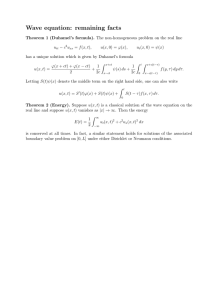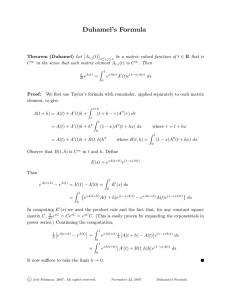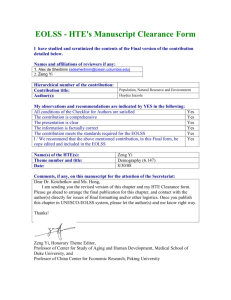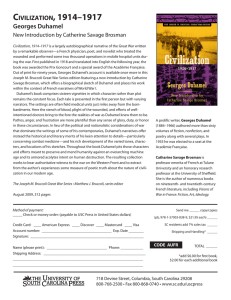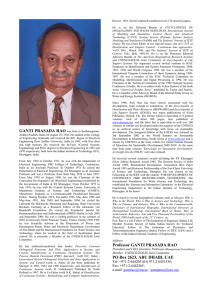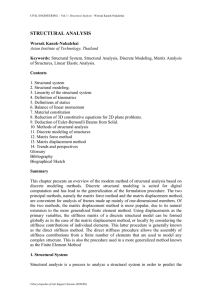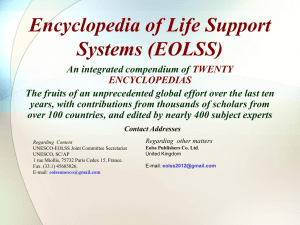Land Use and Land Cover, Including their Classification
advertisement
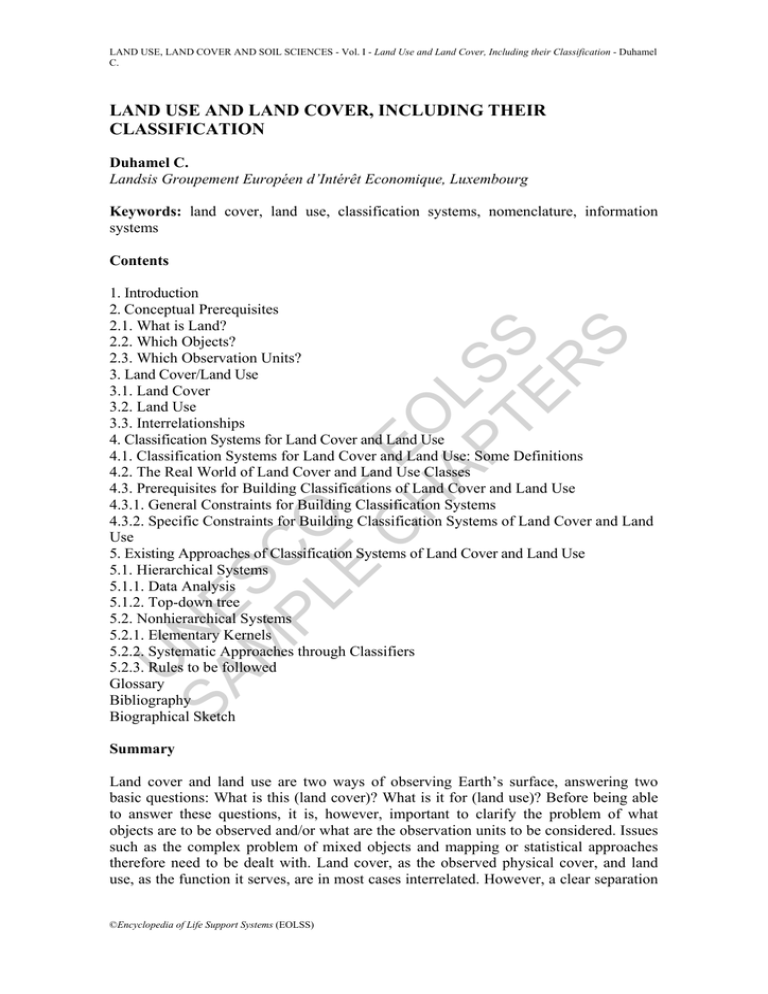
LAND USE, LAND COVER AND SOIL SCIENCES - Vol. I - Land Use and Land Cover, Including their Classification - Duhamel C. LAND USE AND LAND COVER, INCLUDING THEIR CLASSIFICATION Duhamel C. Landsis Groupement Européen d’Intérêt Economique, Luxembourg Keywords: land cover, land use, classification systems, nomenclature, information systems Contents U SA NE M SC PL O E – C EO H AP LS TE S R S 1. Introduction 2. Conceptual Prerequisites 2.1. What is Land? 2.2. Which Objects? 2.3. Which Observation Units? 3. Land Cover/Land Use 3.1. Land Cover 3.2. Land Use 3.3. Interrelationships 4. Classification Systems for Land Cover and Land Use 4.1. Classification Systems for Land Cover and Land Use: Some Definitions 4.2. The Real World of Land Cover and Land Use Classes 4.3. Prerequisites for Building Classifications of Land Cover and Land Use 4.3.1. General Constraints for Building Classification Systems 4.3.2. Specific Constraints for Building Classification Systems of Land Cover and Land Use 5. Existing Approaches of Classification Systems of Land Cover and Land Use 5.1. Hierarchical Systems 5.1.1. Data Analysis 5.1.2. Top-down tree 5.2. Nonhierarchical Systems 5.2.1. Elementary Kernels 5.2.2. Systematic Approaches through Classifiers 5.2.3. Rules to be followed Glossary Bibliography Biographical Sketch Summary Land cover and land use are two ways of observing Earth’s surface, answering two basic questions: What is this (land cover)? What is it for (land use)? Before being able to answer these questions, it is, however, important to clarify the problem of what objects are to be observed and/or what are the observation units to be considered. Issues such as the complex problem of mixed objects and mapping or statistical approaches therefore need to be dealt with. Land cover, as the observed physical cover, and land use, as the function it serves, are in most cases interrelated. However, a clear separation ©Encyclopedia of Life Support Systems (EOLSS) LAND USE, LAND COVER AND SOIL SCIENCES - Vol. I - Land Use and Land Cover, Including their Classification - Duhamel C. of the two approaches is to be recommended for the richness of information it brings. Classification systems of land cover and land use should be built following some rules. First, they should be able to classify all possible objects and arrange these objects in nested categories. Second, they should provide a system for naming and describing the groups of objects. Third, they should allow the decision of membership of one object into the classification. General constraints for building land-cover/land-use classification systems are linked with general constraints of nonoverlapping and completeness, textual rules, and specific constraints linked with time of observation and data collection. U SA NE M SC PL O E – C EO H AP LS TE S R S Among the existing approaches, hierarchical systems such as the top-down tree are the most common approach while nonhierarchical approaches through classifiers are becoming more common. 1. Introduction Any given portion of Earth’s surface can be observed and described in various ways, which differ but may interact according to the distance separating the observer from the observed portion of Earth’s surface; the instruments of observation (human eye, aerial photography, satellite sensors); the way the observation is stored into an information system (lists, nomenclatures, attributes); the observation units chosen (catchment areas, parcels, raster cells, specific objects), and the period of observation. When observing a portion of Earth’s surface, many basic questions may arise: what is this, what is it for, why is it like this, was it like this before, will it stay like this in the future? The two first questions (what is this, what is this for) are of interest to us since they are corresponding to two ways for observing Earth: land cover and land use. We are looking at the material the objects are made of and the function they serve. Distinguishing the concepts of land cover and land use is not a complex task. However, in building information systems we need to address basic issues such as the physical support of the observation (land), the necessary delineation of the considered portions to be taken into account observed (objects and observation units), the type of classification system to construct. 2. Conceptual Prerequisites 2.1. What is Land? Land is a term widely used throughout the world but definitions are not frequently given. Our objective is just to fix the appropriate limits when approaching land cover and land use, to describe the physical “foundations;” the reference areas to be taken into account for land cover and land use. As a first rule, consider the objects above Earth’s surface. This approach is easily understandable for land cover. For land use, the situation is definitely more complicated. From a pragmatic point of view, and considering the importance and the significance in terms of economic value of multiple-use aspects for “urban” areas, the ©Encyclopedia of Life Support Systems (EOLSS) LAND USE, LAND COVER AND SOIL SCIENCES - Vol. I - Land Use and Land Cover, Including their Classification - Duhamel C. understanding of land should embrace uses above and below the ground level. Particular problems may be found with mine deposits, subways beneath urban areas, water resources, and mushroom beds. For example, what should be considered in cases of areas used for oil extraction? Is it the whole field of extraction, and, to a certain extent, the whole oil concession, or is it limited to the oil well itself? In order to restrict the potential problems, it is proposed to handle with reasonable cases, allowing “urban” uses above and below the ground level (case of buildings with shops at ground level, flats and offices above, car parks below) and restricting the typical problem of extraction activities of natural resources (mining, oil extraction, and water resources) to physical impact at ground level (oil well, entrance of mushroom beds, etc.). This principle may be generalized for any kind of uses. U SA NE M SC PL O E – C EO H AP LS TE S R S Another issue is the inclusion of water areas into a concept of land. Given the context of global information systems of land cover and land use and the difficulty of establishing clear thresholds between land and water (particularly for wetlands), it is recommended to extend the concept of land to inland water areas. Figure 1 illustrates this principle. In (1), the area of the oil well on Earth’s surface is taken into account. The area of oil reserves is not taken into account. In (2), the whole building is taken into account, in order to allow estimates of various uses. In (3), the river is included into the land concept. In (4), the subway below the ground level is not taken into account since it has no direct impact at ground level. Figure 1. The “land” of land cover and land use 2.2. Which Objects? If the question of units or objects is self-evident for many scientific fields, this is not at all the case for land. The meaning of object is a complex problem since the categorical classification of a part of Earth’s surface presupposes that the area is clearly defined with physical and visible limits. Objects are easily identifiable if plots of farmland or built-up areas are observed. However, these boundaries become blurred in seminatural or natural environments and delimitation problems are compounded in transitional zones. For example, in the Mediterranean environment, there are indistinct transitions of the biophysical continuum between forests, scrub, and dry grassland. One of the typical problems encountered when land is observed is the problem of mixed objects. Three types of mixtures exist on land. ©Encyclopedia of Life Support Systems (EOLSS) LAND USE, LAND COVER AND SOIL SCIENCES - Vol. I - Land Use and Land Cover, Including their Classification - Duhamel C. U SA NE M SC PL O E – C EO H AP LS TE S R S The first typical case is termed “by juxtaposition” where many objects may be observed simultaneously. This is the case of associated crops on the same parcels. In Figure 2, lines of nut trees are juxtaposed with stripes of wheat. The ways these mixed areas are observed are of course highly dependent on the method of observation and the “distance” with observation. This has impacts on the work of classification, resulting for example in the presence of mixed classes into information systems. In general, a partition into basic objects is recommended or, when not appropriate, the application of a pro-rata rule. In the case presented into Figure 2, a pro-rata rule of 50% for each of the observed land cover would be appropriate. Figure 2. Juxtaposed objects: nuts trees and wheat in France Figure 3. Superposed objects: agriculture on top of housing in China ©Encyclopedia of Life Support Systems (EOLSS) LAND USE, LAND COVER AND SOIL SCIENCES - Vol. I - Land Use and Land Cover, Including their Classification - Duhamel C. The second case is the possibility of having mixed objects by “superposition.” This is the case of the superposition of various land uses in a building or the typical problem of crops under cover. In that case, the distance of observation has no impact but decisions are to be made. Superposition is illustrated in Figure 3 with a particular case where agricultural use on top of residential use may be found. In general, pro-rata or dominance rules are applied for superposed objects. U SA NE M SC PL O E – C EO H AP LS TE S R S The third possibility is the case of mixtures in time: the frequent case of succession of crops, for example. In that case, some rules in terms of date of observation or rules concerning the main commercial value of crops may be applied. Fallow land (Figure 4) is a typical issue in the observation of arable land observation. Figure 4. Variation of covers in time: fallow land In general, applying the pro-rata rule (or, to a certain extent, the dominance rule) has considerable advantages. From a statistical point of view it is important to be able, for example, to count all areas covered by meadows and pastures including areas where meadows may be found under tree cover. From a cartographic point of view, this rule has the advantage of limiting the number of classes in the key map. From a thematic point of view, it is important to be able to describe areas where agriculture and forest may be found on the same area. However, this has some consequences in terms of survey costs and data handling. Conversely, the inclusion of mixed classes has mainly disadvantages. From a statistical point of view, it is difficult to count all areas with a specific cover since this specific cover may be found under different classes. From a cartographic point of view there is a multiplicity of mixed themes to be mapped with arbitrary decisions to be taken on threshold conditions. It is clear that all these aspects concerning land objects should be ©Encyclopedia of Life Support Systems (EOLSS) LAND USE, LAND COVER AND SOIL SCIENCES - Vol. I - Land Use and Land Cover, Including their Classification - Duhamel C. clearly investigated before establishing an information system on land cover and land use. 2.3. Which Observation Units? U SA NE M SC PL O E – C EO H AP LS TE S R S After having considered a general approach to objects, it is important to address the issue of observation units to be chosen. It is important to remember that one observation unit may be an aggregate of objects. Conversely, an object could be divided into various observation units. For example, an observation unit can be a parcel composed of two different crops. A big parcel of wheat may be observed through several units of observation (points in a grid system, cells in a raster system). The choice of observation units is important since it has impacts on the way the information systems will be built: impacts on the reproducibility, and therefore the reliability, of the observation in time. Two main approaches should be considered for land cover and land use: a geographic approach and a statistical one. Through statistical approaches (with the exception of censuses), surveys concerning geographical areas provide information on samples from a population, in our case the whole geographic area under observation. Sampling theory is applied so that inference about the whole area can be made. The sample is made of a set of area units: the statistical units may be of different size (points, areas) or different shape (squares, circles). Figure 5. Area frame sampling in Luxembourg Major advantages of such sampling approaches are the possibility of being independent of the difficult problem of observation units: the population (whole territory) may be divided up into a grid on a systematic basis; each area unit thus obtained being a ©Encyclopedia of Life Support Systems (EOLSS) LAND USE, LAND COVER AND SOIL SCIENCES - Vol. I - Land Use and Land Cover, Including their Classification - Duhamel C. statistical unit (observation unit) of the same size and same shape. This has a particularly big advantage when classes of land cover or land use are defined with boundary conditions based on percentages of cover (for example forestry areas defined on the basis of a certain percentage of canopy). Figure 5 illustrates the statistical approach of the European Union (EU) project Lucas (Land Use Land Cover Area Frame Statistical Survey) where 100 000 observation points in 10 000 segments are surveyed over the whole European Union territory on a systematic grid. The figure shows an example of a primary sampling unit (segment) in Luxembourg where 10 points (secondary sampling units) are visited by surveyors. U SA NE M SC PL O E – C EO H AP LS TE S R S Through mapping approaches, the coverage of the territory is exhaustive. A map is a representation at a given scale. Land cover and “land use” maps are compiled through generally photo-interpretation or processing of aerial photographs and earth observation data together with ground truth. It is important to remind that, through remote sensing techniques, observation is made at a certain distance of the objects with tools trying to “simulate” the human eye. Choice of observation units is driven by technical constraints: the scale of observation (you observe what you can) and the scale of restitution of information (you map what you can) leading to the concept of minimum mapable area. According to scale, identification of objects will not be the same: what you observe and map at 1:10.000, is different from what you observe and map at 1:250,000. Consequently, maps need to deal with legends and not very often with classification systems or nomenclatures. Figure 6 illustrates a common mapping approach on land cover where mixed classes are to be noticed. Figure 6. Land Cover map and legend ©Encyclopedia of Life Support Systems (EOLSS) LAND USE, LAND COVER AND SOIL SCIENCES - Vol. I - Land Use and Land Cover, Including their Classification - Duhamel C. 3. Land Cover/Land Use 3.1. Land Cover Land cover corresponds to a physical description of Earth leading to a simple definition: the observed physical cover of Earth’s surface. This is what is overlaying or currently covering the ground. This description enables various physical categories to be distinguished—basically, areas of vegetation (trees, bushes, fields, lawns), bare soil (even if this is a lack of cover), hard surfaces (rocks, buildings), and, according to the accepted concept of land, wet areas and bodies of water (sheets of water and watercourses, wetlands). U SA NE M SC PL O E – C EO H AP LS TE S R S This definition has consequences for the development of classification systems, data collection, and information systems in general. It is said that land cover is “observed.” This means that observation can be made from various “sources of observation” at different distances between the “observer” and Earth’s surface: the human eye, aerial photographs, satellite sensors. Figure 7 shows an example of land cover in Greece where trees (olive trees) and cropland (barley) are coexisting. Apparently these areas are also “covered” with goats appreciating barley. Figure 7. Greek land covers - TO ACCESS ALL THE 21 PAGES OF THIS CHAPTER, Visit: http://www.eolss.net/Eolss-sampleAllChapter.aspx ©Encyclopedia of Life Support Systems (EOLSS) LAND USE, LAND COVER AND SOIL SCIENCES - Vol. I - Land Use and Land Cover, Including their Classification - Duhamel C. Bibliography Africover. (1997). Africover Land Cover Classification, 76pp. Rome: FAO. [This document shows how a classifier approach has been utilized for mapping land cover in Eastern Africa .] Anderson J.R. (1976). A Land Use and Land Cover Classification System for use with Remote Sensor Data, Professional Paper 964, 28 pp. Washington, DC: U.S. Geological Survey. [This article is the best example of what should not be done on mixing land cover and land use and basing a classification linked to earth observation.] Economic Commission for Europe, United Nations (ECE-UN) (1989). Standard International Classification of Land Use, 27 pp. Geneva: Economic Commission for Europe, United Nations. [This paper shows a typical example of a hierarchic system mixing—with difficulties—land cover and land use.] Ekholm A. (1996). A Conceptual Framework for Classification of Construction Works, 25 pp. Lund, Sweden: University of Lund. [This paper is a very good theoretical introduction to classifiers in another field: construction.] U SA NE M SC PL O E – C EO H AP LS TE S R S Eurostat. (2000). Manual of Concepts on Land Cover and Land Use, 125 pp. Luxembourg: EU. [This manual is a good and comprehensive basis for starting an information system on land cover and land use.] Eurostat. (2001). Land Cover Land Use Area Frame Sampling Survey, Nomenclature, Technical Document 2, 107 pp. Luxembourg: EU. [This document is a good example of a separated system of classification on land cover and land use including good examples for textual part and annexes.] LANES (Land Use Information Systems Derived from Earth Observation Data) (1997). Development of a Harmonised Framework for Multi-Purpose Land Cover/Land Use Information Systems derived from Earth Observation Data, 50 pp. Luxembourg: European Commission, CESD-Communautaire. [This report addresses specific problems of nomenclatures and classification systems in general on the specific field of land cover and land use.] Sokal R.R. and Sneath P.H.A. (1974). Numerical Taxonomy: the Principles and Practice of Numerical Classification, San Francisco: W.H. Freeman and Company. [This book is the basis of numerous methodological works on classifications, even if not always the most appropriate in our field.] UN Statistics Division. (1996) International Standard Industrial Classification for all Economic Activities, Revision 3, 287 pp. New York: United Nations. [This document is the standard classification of economic activities, to which land use should be matched.] Biographical Sketch Christophe Duhamel is general manager of Landsis g.e.i.e., a European group working in the field of agricultural and environmental statistics. He has studied geography and cartography in Paris. In addition to his present managerial tasks he has conducted various studies and methodological work in the field of land cover—land use information systems for the benefit of the European Commission and FAO. He is a specialist of classification systems on land cover and land use and has developed the classification system utilized for the LUCAS survey in Europe. He also worked in Mozambique in the field of agricultural surveys. ©Encyclopedia of Life Support Systems (EOLSS)
